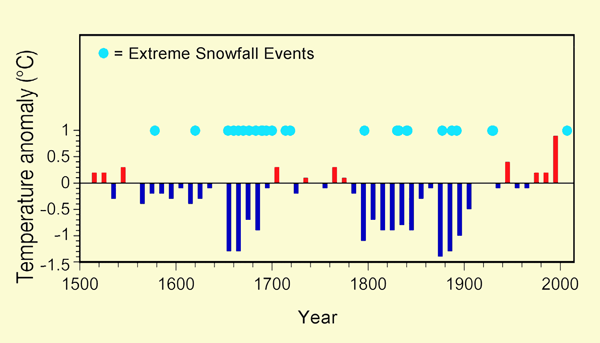Reference
Hao, Z., Zheng, J., Ge, Q. and Wang, W.-C. 2011. Historical analogues of the 2008 extreme snow event over Central and Southern China. Climate Research 50: 161-170.
Background
From 10 January to 2 February 2008, in the words of the authors, "continuous heavy snowfall occurred over Central and Southern China (Ding et al., 2008; Wen et al., 2009)," causing "1.7 million people to be displaced for periods ranging between a few days to a month," and affecting "critical infrastructure including electric power grids and communication systems," while "food production, forests, wildlife and buildings all suffered heavy damage (Zhou et al., 2011)," which resulted in "direct economic losses of over 151.65 billion Yuan (~US $21 billion; Ministry of Civil Affairs, 2008)."
What was done
To determine just how unique the 2008 extreme snow event (ESE) was, in light of climate-alarmist claims that all sorts of weather extremes will accompany CO2-induced global warming, the four researchers "used weather records contained in Chinese historical documents from the past 500 years to search for ESEs that were comparable in severity," because, as they continue, such extreme events "beg the question of whether historical analogues can be found, and if so, how often they occurred in connection with the main temperature phase (cold/warm)." In pursuit of this goal, they defined an ESE as having "more than 15 snowfall days, 20 snow-cover/icing days, and 30 cm total cumulated snow depth for an individual winter," while they used a winter half-year temperature reconstruction to reveal decadal temperature change over central Eastern China for the years 1500-2000, in order "to provide a climatic background for the ESEs that occurred."
What was learned
Hoa et al. report that they identified 25 additional ESEs that were "comparable to the extreme snow event in 2008 in terms of snowfall days, snow cover/icing days and snow depth," and a graph of their data indicates that all of the additional ESEs occurred during periods that were colder than the past decade. In fact, all but maybe one of the additional ESEs occurred in times when winter temperatures were below the even colder 1951-1980 average.

Winter half-year temperature anomalies (with respect to 1951-1980 means) reconstructed from Chinese historical documents covering the past 500 yr for Eastern China, and the years with extreme snow event (ESE) occurrences (light-blue circles). Adapted from Hao et al. (2011).
What it means
In concluding the report of their study, the four scientists write that "currently, one of the many active research topics under 'climate change' is 'extremes'," obliquely noting that their results reveal, as they describe it, "what we have learned from the past," which is that this particular extreme has become much less common than it was in colder times.
References
Ding, Y.H., Wang, Z.Y., Song, Y.F. and Zhang, J. 2008. The unprecedented freezing disaster in January 2008 in Southern China and its possible association with the global warming. Acta Meteorologica Sinica 22: 538-558.
Ministry of Civil Affairs. 2008. Report on the Impact of the Recent Ice Storm and the Disaster Relief. Ministry of Civil Affairs of the People's Republic of China. Available online at www.mca.gov.cn/article/zwgk/mzyw/200802/20080200011960.shtml.
Wen, M., Yang, S., Kumar, A. and Zhang, P. 2009. An analysis of the large-scale climate anomalies associated with the snow-storms affecting China in January 2008. Monthly Weather Review 137: 1111-1131.
Zhou, B.Z., Gu, L.H., Ding, Y.H., Shao, L., Wu, Z., Yang, X., Li, C., Li, Z., Wang, X., Cao, Y., Zeng, B., Yu, M., Wang, M., Wang, S., Sun, H., Duan, A., An, Y., Wang, X. and Kong, W. 2011. The great 2008 Chinese ice storm: its socioeconomic-ecological impact and sustainability lessons learned. Bulletin of the American Meteorological Society 92: 47-60.
Reviewed 21 March 2012



